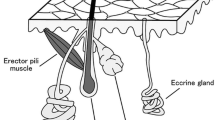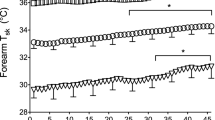Abstract
Purpose
We investigated the effects of humidity on regional sweating secretion and active sweat gland density on the scalp during passive heating in hot environments.
Methods
Eight male subjects shaved their heads prior to expose to dry (30%RH; H30%) and humid (85%RH; H85%) conditions at an air temperature of 32 °C. Total sweat rate, local sweat rates (frontal, vertex, temporal, and occipital regions), active sweat glands on the scalp (2 frontal, 2 parietal, 2 temporal, 1 occipital, and 1 vertex), and rectal and skin temperatures were measured during leg immersion in 42 °C water for 60 min.
Results
(1) Total sweat rates were greater for H30% (179.4 ± 35.6 g h−1) than for H85% (148.1 ± 27.2 g h−1) (P < 0.05). (2) Scalp sweat secretion tended to be greater in the H85% than the H30%. (3) Head sweat rates were greater on the frontal than on the vertex for both humidity conditions (P < 0.05). (4) Active sweat gland density on the scalp was greater for H85% (82 ± 13 glands cm−2) than for H30% (62 ± 17 glands cm−2) (P < 0.05). (5) No significant difference was found in rectal temperature between H30% and H85%, whereas mean skin temperature was significantly lower for H30% (34.8 ± 0.7 °C) than for the H85% condition (36.0 ± 0.3 °C) (P < 0.05).
Conclusions
These results indicate that the thermoregulatory sweating responses for the scalp region were significantly increased in the hot-humid condition compared to the hot-dry condition. Among the regions on the scalp surface, the vertex was the least sensitive to the change in humidity.








Similar content being viewed by others
Abbreviations
- ASG:
-
Active sweat glands
- HD:
-
Hot and dry condition
- HH:
-
Hot and humid condition
- HR:
-
Heart rate
- LSR:
-
Local sweat rate
- TEWL:
-
Transepidermal water loss
- T re :
-
Rectal temperature
- T sk :
-
Skin temperature
- TSR:
-
Total sweat rate
References
Aisenson MR (1950) Closing of the anterior fontanelle. Pediatrics 6(2):223–226
Blair DA, Glover WE, Roddie IC (1960) Vasomotor fibres to skin in the upper arm, calf and thigh. J Physiol 153(2):232–238
Brebner DF, Kerslake DM (1964) The time course of the decline in sweating produced by wetting the skin. J Physiol 175(2):295–302
Brebner DF, Kerslake DM, Waddell JL (1958) The effect of atmospheric humidity on the skin temperatures and sweat rates of resting men at two ambient temperatures. J Physiol 144:299–306
Cabanac M, Brinnel H (1988) Beards, baldness, and sweat secretion. Eur J Appl Physiol Occup Physiol 58(1–2):39–46
Candas V, Libert JP, Vogt JJ (1979) Human skin wettedness and evaporative efficiency of sweating. J Appl Physiol 46:522–528
Candas V, Libert JP, Vogt JJ (1980) Effect of hidromeiosis on sweat drippage during acclimation to humid heat. Eur J Appl Physiol Occup Physiol 44:123–133
Che Muhamed AM, Atkins K, Stannard SR, Mündel T, Thompson MW (2016) The effects of a systematic increase in relative humidity on thermoregulatory and circulatory responses during prolonged running exercise in the heat. Temperature 3(3):455–464
Cotter JD, Patterson MJ, Taylor NA (1995) The topography of eccrine sweating in humans during exercise. Eur J Appl Physiol Occup Physiol 71(6):549–554
Epstein Y, Moran DS (2006) Thermal comfort and the heat stress indices. Ind Health 44:388–398
Fox RH, Goldsmith R, Kidd DJ (1962) Cutaneous vasomotor control in the human head, neck and upper chest. J Physiol 161(2):298–312
Froese G, Burton AC (1957) Heat losses from the human head. J Appl Physiol 10(2):235–241
Gagge AP, Gonzalez RR (1996) Mechanisms of heat exchange: biophysics and physiology. In: Fregly MJ, Blatteis CM (eds) Handbook of physiology, section 4: environmental physiology, vol 1. Oxford University Press, New York, pp 45–84
Hammel HT, Pierce JB (1968) Regulation of internal body temperature. Annu Rev Physiol 30:641–710
Hardy JD, DuBois EF (1938) The technic of measuring radiation and convection. J Nutr 15:461–475
Havenith G, Fogarty A, Bartlett R, Smith CJ, Ventenat V (2008) Male and female upper body sweat distribution during running measured with technical absorbents. Eur J Appl Physiol 104:245–255
Hertig BA, Riedesel ML, Belding HS (1961) Sweating in hot baths. J Appl Physiol 16(4):647–651
Hertzman AB, Roth LW (1942) The absence of vasoconstrictor reflexes in the forehead circulation. Effects of cold. Am J Physiol 136(4):692–697
Hertzman AB, Randall WC, Peiss CN, Seckendorf R (1952) Regional rates of evaporation from the skin at various environmental temperatures. J Appl Physiol 5:153–161
Hwang K, Baik SH (1997) Distribution of hairs and sweat glands on the bodies of Korean adults: a morphometric study. Cells Tissues Organs 158(2):112–120
ISO 10551 (1995) Ergonomics of the thermal environment: assessment of the influence of the thermal environment using subjective judgement scales. International Organization for Standardization
Jung DJ (1994) The difference of the sweat rate and skin temperature according to environments during submaximal exercise. J Kor Soc Tan-Therm Environ Sys 1:49–54
Jung D, Kim D, Park J, Lee JY (2016) Greater body mass index is related to greater self-identified cold tolerance and greater insensible body mass loss. J Physiol Anthropol 35(1):16
Kerslake DM (1972) The stress of hot environments. Monographs of die physiological society (No. 29). Cambridge University Press, London
Kim YB, Jung D, Park J, Lee JY (2017) Sensitivity to cutaneous warm stimuli varies greatly in the human head. J Therm Biol 69:132–138
Kuno Y (1956) Human perspiration. Thomas, Springfield, IL
Lee JB, Kim JH (2018) Decreased thermal sweating of central sudomotor mechanism in African and Korean men. Am J Hum Biol. https://doi.org/10.1002/ajhb.23091 (in press)
Lee JB, Shin YO (2017) Comparison of density and output of sweat gland in tropical Africans and temperate Koreans. Auton Neurosci Basic Clin 205:67–71
Lee JY, Choi JW, Kim H (2008) Determination of body surface area and formulas to estimate body surface area using the Alginate method. J Physiol Anthropol 27(2):71–82
Lee JY, Nakao K, Tochihara Y (2010) Chest, abdomen or back: selecting an optimum trunk region for Hardy and DuBois’ weighted mean skin temperature formula. J Hum Environ Syst 13(1):7–14
Machado-Moreira CA, Smith FM, van den Heuvel AM, Mekjavic IB, Taylor NA (2008a) Sweat secretion from the torso during passively-induced and exercise-related hyperthermia. Eur J Appl Physiol 104(2):265–270
Machado-Moreira CA, Wilmink F, Meijer A, Mekjavic IB, Taylor NA (2008b) Local differences in sweat secretion from the head during rest and exercise in the heat. Eur J Appl Physiol 104(2):257–264
Machado-Moreira CA, Caldwell JN, Mekjavic IB, Taylor NA (2008c) Sweat secretion from palmar and dorsal surfaces of the hands during passive and active heating. Aviat Space Environ Med 79(11):1034–1040
Maughan RJ, Otani H, Watson P (2012) Influence of relative humidity on prolonged exercise capacity in a warm environment. Eur J Appl Physiol 112(6):2313–2321
Nadel ER, Stolwijk JA (1973) Effect of skin wettedness on sweat gland response. J Appl Physiol 35(5):689–694
Nadel ER, Bullard RW, Stolwijk JA (1971) Importance of skin temperature in the regulation of sweating. J Appl Physiol 31(1):80–87
O’Brien C, Cadarette BS (2013) Quantification of head sweating during rest and exercise in the heat. Eur J Appl Physiol 113:735–741
Ogoh S, Sato K, Okazaki K, Miyamoto T, Hirasawa A, Morimoto K, Shibasaki M (2013) Blood flow distribution during heat stress: cerebral and systemic blood flow. J Cereb Blood Flow Metab 33(12):1915–1920
Park SJ, Lee JY (2016) Number of active sweat glands and its reliability in measurements using starch-iodine paper method. J Korean Soc Living Environ 23(5):659–667
Patterson MJ, Galloway SD, Nimmo MA (2000) Variations in regional sweat composition in normal human males. Exp Physiol 85:869–875
Peiss CN, Randall WC, Hertzman AB (1956) Hydration of the skin and its effect on sweating and evaporative water loss. J Investig Dermatol 26(6):459–470
Sato K, Sato F (1983) Individual variations in structure and function of human eccrine sweat gland. Am J Physiol Regul Integr Comp Physiol 245(2):R203–R208
Sato F, Owen M, Matthes R, Sato K, Gisolfi CV (1990) Functional and morphological changes in the eccrine sweat gland with heat acclimation. J Appl Physiol 69(1):232–236
Senay JR, Leo C, Christensen M, Hertzman AB (1961) Cutaneous vasodilatation elicited by body heating in calf, forearm, cheek, and ear. J Appl Physiol 16(4):655–659
Smith CJ, Havenith G (2011) Body mapping of sweating patterns in male athletes in mild exercise-induced hyperthermia. Eur J Appl Physiol 111(7):1391–1404
Smith CJ, Ventenat V, Havenith G (2007) Regional sweat rates of the arms and hands in male squash players. International Conference on Environmental Ergonomics XII, p 285
Szabo G (1962) The number of eccrine sweat glands in human skin. Adv Biol Skin 3:1–5
Taylor NA, Machado-Moreira CA (2013) Regional variations in transepidermal water loss, eccrine sweat gland density, sweat secretion rates and electrolyte composition in resting and exercising humans. Extreme Physiol Med 2(1):4
Taylor NA, Caldwell JN, Mekjavic IB (2006) The sweating foot: local differences in sweat secretion during exercise-induced hyperthermia. Aviat Space Environ Med 77(10):1020–1027
Walters TJ, Ryan KL, Constable SH (2004) Thermoregulation by rhesus monkeys at different absolute humidities. J Comp Physiol B 174(6):481–487
Weiner JS (1945) The regional distribution of sweating. J Physiol 104:32–40
Acknowledgements
We truly appreciate the subjects who shaved their hair for this experiment, and are thankful Yoon-Jeong Huh and Andrew Gorski for their technical support. This research was supported by Aspiring Researcher Program through Seoul National University (SNU) in 2014 and Nano·Material Technology Development Program through the National Research Foundation of Korea (NRF) funded by the Ministry of Science, ICT and Future Planning (no. 2016M3A7B4910).
Author information
Authors and Affiliations
Contributions
Its publication has been approved by all co-authors. All authors have contributed to the planning, preparation, data collection, analysis, and the writing of this manuscript, such that their contributions satisfy all requirements of authorship.
Corresponding author
Ethics declarations
Conflict of interest
The authors declare that they have no conflict of interest.
Ethical approval
All procedures were performed in accordance with the ethical standards of the institutional research committee and with the 1964 Helsinki declaration and its later amendments or comparable ethical standards.
Additional information
Communicated by George Havenith.
Rights and permissions
About this article
Cite this article
Jung, D., Kim, YB., Lee, JB. et al. Sweating distribution and active sweat glands on the scalp of young males in hot-dry and hot-humid environments. Eur J Appl Physiol 118, 2655–2667 (2018). https://doi.org/10.1007/s00421-018-3988-7
Received:
Accepted:
Published:
Issue Date:
DOI: https://doi.org/10.1007/s00421-018-3988-7




